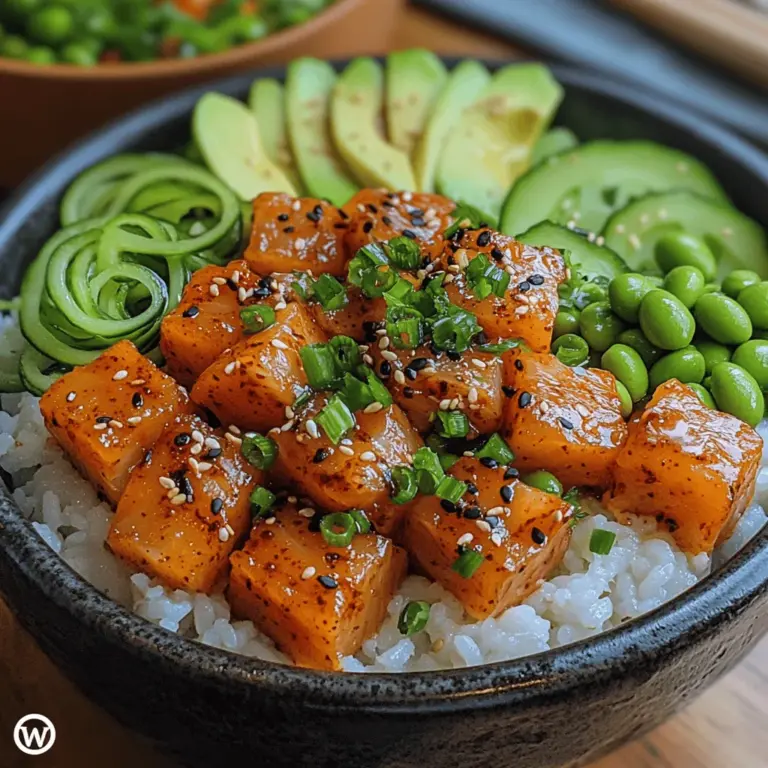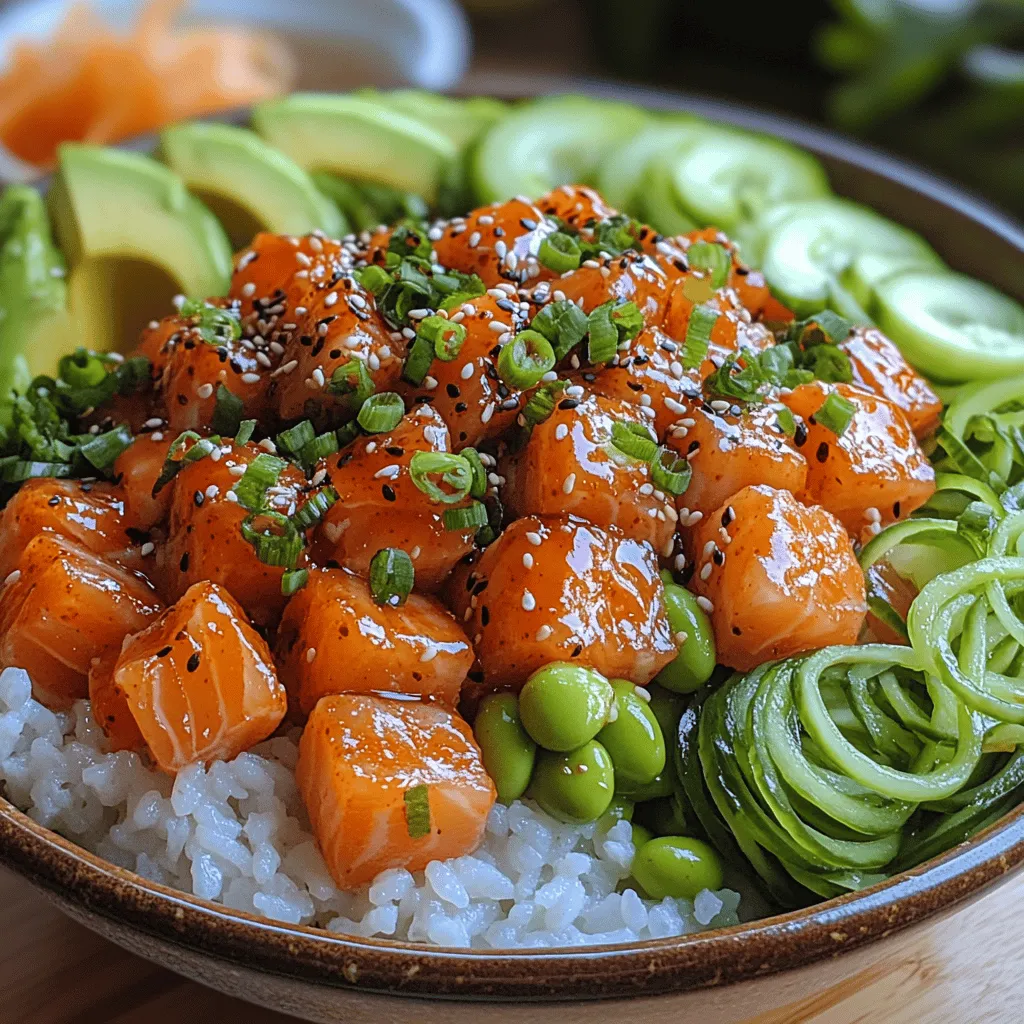Introduction
Sushi bowls, or chirashi, have seen a meteoric rise in popularity over the past few years, captivating food enthusiasts with their fresh, vibrant ingredients and customizable nature. Unlike traditional sushi rolls, which require precise rolling techniques, sushi bowls allow you to create a stunning meal in a bowl, combining all of your favorite sushi elements in one delicious package. They are not only visually appealing but also incredibly versatile, making them a perfect choice for any occasion, whether you’re hosting a dinner party or enjoying a quiet meal at home.
Among the myriad of sushi bowl options available, Spicy Tuna Sushi Bowls stand out as a particularly delightful choice. With their harmonious balance of flavors and textures, these bowls are a feast for the senses. Creamy avocado, tender sushi rice, and spicy tuna come together in a perfect union, offering a delightful crunch from fresh vegetables and a zing from zesty sauces. This dish not only pleases the palate but also satisfies the craving for something fresh and healthy.
Speaking of health, the ingredients used in Spicy Tuna Sushi Bowls provide numerous nutritional benefits. Tuna is an excellent source of lean protein, omega-3 fatty acids, and essential vitamins, while avocado contributes healthy fats, fiber, and a wealth of nutrients. Together, they create a dish that is not only delicious but also nourishing.
Understanding Sushi Rice
At the heart of any sushi bowl lies sushi rice, a special short-grain rice that is vital for achieving the right texture and flavor. Sushi rice is sticky when cooked, allowing it to hold its shape and form the perfect base for your sushi bowl. The quality and preparation of sushi rice can significantly impact the overall experience of your dish, making it essential to select the right type and prepare it with care.
Selecting the Right Type of Rice for Sushi
When choosing sushi rice, look for high-quality short-grain rice, often labeled as “sushi rice” or “Calrose rice.” This type of rice has a higher starch content than long-grain varieties, resulting in a sticky texture that is ideal for sushi. You can find sushi rice in most grocery stores or Asian markets. Avoid using regular long-grain rice, as it will not yield the same desirable texture.
How to Rinse and Cook Sushi Rice Perfectly
1. Rinsing the Rice: Start by measuring out your sushi rice—typically, one cup serves about two people. Place the rice in a fine-mesh strainer and rinse it under cold water. Use your hands to gently agitate the rice, allowing the water to wash away excess starch. Rinse until the water runs clear, which usually takes about 3-4 rinses. This step is crucial for preventing the rice from becoming gummy.
2. Cooking the Rice: After rinsing, transfer the rice to a rice cooker or a medium saucepan. Add water in a 1:1 ratio; for every cup of rice, use one cup of water. If using a rice cooker, simply set it to the sushi setting and let it cook. If using a saucepan, bring the water to a boil, then reduce the heat to low, cover, and simmer for about 18-20 minutes. Once the rice is cooked, allow it to rest for 10 minutes off the heat before uncovering.
Seasoning Sushi Rice for Authentic Flavor
To achieve authentic sushi rice flavor, you must season the cooked rice. In a small bowl, mix together rice vinegar, sugar, and salt. A general guideline is to use ¼ cup of rice vinegar, 2 tablespoons of sugar, and 1 teaspoon of salt for every cup of uncooked rice. Heat this mixture gently until the sugar and salt dissolve, then fold it into the still-warm rice using a wooden spatula. Be gentle to avoid mashing the grains, and allow the rice to cool to room temperature before assembling your sushi bowl.
Choosing the Right Tuna
When it comes to preparing Spicy Tuna Sushi Bowls, the quality of the tuna is paramount. Since this dish features raw fish, it is essential to use sashimi-grade tuna, which is specifically handled and prepared for raw consumption. This ensures the fish is fresh and safe to eat, providing the best flavor and texture for your sushi bowl.
Selecting Fresh Tuna from the Market
When selecting tuna, look for vibrant color and a clean, ocean-like smell. Fresh tuna should have a deep red color, indicating its freshness. Avoid any tuna that appears dull or has a brownish hue, as this may indicate it is past its prime. If purchasing from a fishmonger, don’t hesitate to ask about the fish’s source and how long it has been in the display case. If you’re buying pre-packaged tuna, check the sell-by date to ensure you’re getting the freshest product.
Safety Tips for Handling Raw Fish
Handling raw fish requires utmost care to ensure food safety. Always wash your hands thoroughly before and after handling tuna. Use a clean cutting board and knife dedicated to raw fish to avoid cross-contamination. If you’re not planning to use the tuna immediately, store it in the coldest part of your refrigerator, ideally on ice, and consume it within 24 hours for the best quality.
Alternative Proteins for Non-Seafood Lovers
If you or your guests are not fans of seafood, don’t worry—there are plenty of alternatives to create a delicious sushi bowl. Grilled chicken, marinated tofu, or even roasted vegetables can serve as excellent substitutes. For an Asian-inspired twist, consider using teriyaki chicken or spicy grilled shrimp. The key is to maintain the balance of flavors typical of sushi bowls while accommodating different dietary preferences.
Creating the Spicy Tuna Mixture
The star of the Spicy Tuna Sushi Bowl is, of course, the spicy tuna mixture. This delightful blend of ingredients not only enhances the natural flavor of the tuna but also adds layers of complexity to the dish. Here’s a breakdown of each ingredient that makes this mixture a standout.
Ingredients in the Spicy Tuna Mixture
1. Sashimi-Grade Tuna: The foundation of the mixture, providing a rich and buttery texture.
2. Soy Sauce: This umami-rich sauce enhances the natural flavors of the tuna, adding depth to the dish.
3. Sriracha: For a spicy kick, sriracha brings heat and a touch of sweetness. Adjust the amount based on your spice tolerance.
4. Sesame Oil: A drizzle of sesame oil adds a nutty richness that complements the fish beautifully.
5. Green Onions: Chopped for a fresh, mild onion flavor that brightens the mixture.
6. Cucumber: Diced cucumber adds a refreshing crunch and balances the spiciness.
7. Sesame Seeds: Toasted sesame seeds can be sprinkled on top for an added crunch and nutty flavor.
Adjusting Spice Levels to Suit Personal Preferences
One of the best aspects of Spicy Tuna Sushi Bowls is their adaptability. If you prefer a milder flavor, simply reduce the amount of sriracha used in the mixture. Alternatively, if you enjoy a more robust heat, consider adding a dash of chili oil or a sprinkle of crushed red pepper flakes. Taste the mixture as you go to find the perfect balance that suits your palate.
As you prepare your Spicy Tuna Sushi Bowl, remember that the beauty of this dish lies in its customizability. Not only can you adjust the spice levels, but you can also play with the toppings and ingredients to create a bowl that is uniquely yours. Whether you prefer an abundance of fresh vegetables, a hint of citrus, or a drizzle of your favorite sauce, the possibilities are endless.
Tips for Ensuring the Tuna is Perfectly Coated Without Being Overmixed
When preparing your Spicy Tuna Sushi Bowls, one of the critical steps is ensuring that you achieve the perfect texture and flavor balance in your tuna mixture. Here are some tips to help you coat your tuna without overmixing, preserving its delicate texture:
1. Use Quality Tuna: Start with high-quality, sushi-grade tuna. Freshness is key, as it enhances both flavor and texture. Look for bright, vibrant red tuna with a firm consistency.
2. Cut Uniform Pieces: Dice the tuna into small, uniform cubes. This helps the marinade coat each piece evenly and reduces the risk of mashing the fish during mixing.
3. Gentle Mixing: When combining the tuna with the spicy mayo and other ingredients, use a gentle folding technique rather than stirring vigorously. This will help maintain the integrity of the tuna while ensuring that each piece is adequately coated.
4. Let it Marinate: Allow the tuna to marinate in the spicy mayo for about 10 minutes before serving. This short marination time infuses flavor without compromising the fish’s texture.
5. Taste as You Go: Before serving, taste the tuna mixture and adjust the seasoning if necessary. This allows you to control the flavor without overworking the fish.
Assembling Your Sushi Bowl
Presentation plays a vital role in the enjoyment of sushi bowls, transforming a simple dish into a culinary masterpiece. Here’s how to layer your ingredients for maximum visual appeal:
Step-by-Step Guide on How to Layer the Ingredients
1. Start with a Base: Begin by adding a generous scoop of sushi rice at the bottom of your bowl. This will serve as the foundation for your sushi bowl.
2. Add the Tuna: Next, place your perfectly coated spicy tuna in the center of the rice. This not only highlights the star ingredient but also allows the vibrant color of the tuna to pop against the white rice.
3. Incorporate Vegetables: Arrange your sliced avocado and edamame around the tuna. The creamy green avocado and bright green edamame provide a beautiful contrast to the red tuna.
4. Garnish: Sprinkle sesame seeds and sliced green onions over the top for added texture and flavor. You can also add a few slices of pickled ginger on the side for a refreshing touch.
5. Drizzle Sauce: Finish with a drizzle of extra spicy mayo, soy sauce, or ponzu sauce for added flavor and a glossy finish.
Suggestions for Bowl Types and Sizes
When it comes to choosing bowls for your sushi bowls, consider the following:
– Bowl Size: Opt for medium-sized bowls that can comfortably hold all your ingredients without overflowing. A 6 to 8-inch bowl is typically ideal for individual servings.
– Material: Choose bowls made from materials like ceramic or bamboo that not only look appealing but also keep your food warm longer.
– Style: Traditional Japanese-style bowls can enhance the overall aesthetic of your dish, giving it an authentic feel.
Creative Ideas for Alternative Toppings and Variations for Customization
One of the best aspects of sushi bowls is their versatility. Here are some alternative toppings and variations you can try:
– Protein Alternatives: Instead of tuna, you can use salmon, shrimp, or tofu for a vegetarian option. Each brings a unique flavor profile and texture.
– Additional Veggies: Consider adding shredded carrots, sliced radishes, or cucumber for extra crunch and color.
– Fruits: Mango or pineapple can add a sweet contrast to the spice of the tuna.
– Nuts and Seeds: Top with crushed nori, macadamia nuts, or pumpkin seeds for an unexpected crunch.
– Different Sauces: Experiment with different sauces like teriyaki, sriracha, or even a wasabi aioli to switch things up.
Nutritional Benefits of Spicy Tuna Sushi Bowls
Spicy Tuna Sushi Bowls are not only delicious but also packed with nutritional benefits from their main ingredients. Here’s a closer look at their health advantages:
Overview of the Nutritional Benefits of the Main Ingredients
– Tuna: Rich in omega-3 fatty acids, tuna is known for its heart-healthy benefits. It is also an excellent source of protein, essential for muscle repair and growth.
– Avocado: This creamy fruit provides healthy monounsaturated fats that can help lower cholesterol levels. Avocado is also high in vitamins E, K, and C, along with potassium and fiber.
– Edamame: These young soybeans are a great source of plant-based protein, fiber, and essential nutrients like iron and calcium. They also offer antioxidant properties.
Discussion on Healthy Fats, Protein Content, and Vitamins
The combination of these ingredients in your sushi bowl provides a balanced meal. The healthy fats from avocado support heart health and aid in nutrient absorption, while the protein from tuna and edamame helps you feel full and satisfied. Additionally, vitamins and minerals from the fresh vegetables contribute to overall wellness.
Comparison of Sushi Bowls to Traditional Sushi Rolls in Terms of Nutrition
In comparison to traditional sushi rolls, which often contain refined white rice and may include fried or heavily processed ingredients, sushi bowls offer a more nutritious alternative. Sushi bowls typically feature brown rice or quinoa as a base, which adds more fiber and nutrients. Additionally, bowls allow for more vegetables and toppings, making it easier to pack in the nutrients.
Encouragement of Mindful Eating Practices with Sushi Bowls
Mindful eating can enhance your dining experience. Take the time to savor each layer of flavor and texture in your sushi bowl. By engaging your senses—sight, smell, taste—you can appreciate the freshness of the ingredients and the effort you put into crafting your meal.
Serving Suggestions and Pairings
To elevate your Spicy Tuna Sushi Bowls, consider these serving suggestions and pairing ideas:
Ideas for Side Dishes that Complement Spicy Tuna Sushi Bowls
– Miso Soup: A warm bowl of miso soup is a classic pairing that enhances the overall sushi experience.
– Seaweed Salad: This refreshing side dish adds a burst of flavor and complements the sushi bowl seamlessly.
– Pickled Vegetables: A small serving of pickled vegetables can provide a tangy contrast to the rich flavors of the tuna.
Suggestions for Beverages that Pair Well with the Dish
– Green Tea: The subtle flavors of green tea pair well with sushi and aid digestion.
– Sake: For an authentic Japanese experience, serve your sushi bowl with sake. Both warm and cold varieties can enhance the meal.
– Sparkling Water: If you prefer non-alcoholic options, sparkling water with a twist of lime can cleanse the palate beautifully.
Cultural Significance of Sushi Bowls and Their Place in Japanese Cuisine
Sushi bowls, or chirashi, are a beloved part of Japanese cuisine. Traditionally served during celebrations, chirashi showcases the beauty of seasonal ingredients and the art of presentation. By making sushi bowls at home, you not only embrace these culinary traditions but also create a personal touch that reflects your taste.
Highlighting the Versatility of Sushi Bowls for Various Occasions
Sushi bowls are incredibly versatile, suitable for a range of occasions—from casual weeknight dinners to special celebrations. Customize your bowls to suit different dietary preferences, making them a crowd-pleaser for gatherings, potlucks, or simple weeknight meals. Their adaptability ensures that everyone can enjoy a delicious and healthy meal.
Conclusion
Crafting Spicy Tuna Sushi Bowls at home brings joy and satisfaction, allowing you to explore your culinary creativity. The process of assembling your bowl, selecting fresh ingredients, and presenting them beautifully is an art in itself. As you experiment with this recipe, don’t hesitate to make it your own by incorporating your favorite flavors and toppings.
By embracing the versatility of sushi bowls, you not only create a delicious meal but also engage in a mindful eating experience. Encourage yourself to explore different textures, colors, and tastes, turning each bowl into a unique expression of your culinary journey. Enjoy the process, savor the flavors, and happy cooking!



